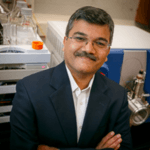
- This event has passed.
Kannan/Buckley: Assessment of Exposure to Chemicals of Uncertain Body Burden and Multi-panel Chemical Assay for Analysis in ECHO
May 12, 2021 @ 1:00 pm - 2:00 pm
Assessment of Exposure to Chemicals of Uncertain Body Burden and Multi-panel Chemical Assay for Analysis in ECHO |
Speakers:
 Dr. Kurunthachalam Kannan, PhD
Dr. Kurunthachalam Kannan, PhD
Department of Pediatrics, New York University School of Medicine
Speaker Bio: Dr. Kurunthachalam Kannan is a Professor in the Department of Pediatrics, Division of Environmental Pediatrics at New York University School of Medicine. He has published over 750 research articles in peer-reviewed journals, 25 book chapters and co-edited a book. Dr. Kannan is the top 5 most highly cited researchers (ISI) in Ecology/Environment globally with an H-index of 135 (google scholar) or 114 (scopus). He is known for his work on the discovery of perfluorochemicals in the global environment, among several other emerging chemicals of human health concern. His research program incorporates a unique combination of biomonitoring and environmental monitoring of human exposure to organic pollutants. He has mentored over 20 graduate students and advised over 70 postdoctoral research associates in his laboratory.
 Dr. Jessie Buckley, PhD, MPH
Dr. Jessie Buckley, PhD, MPH
Environmental Health and Engineering & Epidemiology, Johns Hopkins University Bloomberg School of Public Health
Speaker Bio: Dr. Jessie Buckley, PhD, MPH is an Associate Professor of Environmental Health & Engineering and Epidemiology (joint) at the Johns Hopkins Bloomberg School of Public Health. As an environmental and pediatric/perinatal epidemiologist, her research aims to characterize environmental exposures during early life and determine their effects on child growth and development. Dr. Buckley earned her MPH in Environmental and Occupational Health from the George Washington University and PhD in Epidemiology from the University of North Carolina at Chapel Hill.
Date: Tuesday, May 12th, 1 to 2pm
Questions/Comments and Feedback:
Can you comment on how many standards were not available? Also, your thoughts on our prioritization process vs. what chemicals were eventually ended up being measured. Will be such a great resource for many many research projects.
Response: Thanks. We contacted every commercial vendor of analytical standards in North America and some European vendors. We were able to acquire all 121 native standards. However isotope labeled internal standards were available only for 92 compounds. Isotope labeled standards are important for accurate quantification. However, if we have multiple isomers of a same compound, one isotope labeled standard is sufficient to cover all isomers. The publication in Journal of Chromatography A volume 1646, #462146 has the list of all 121 chemicals.
What is the length of time for the steps in the analytic method development?
Response: I assume the question is about how long it took to develop the method described. Two well trained postdocs along with a technician worked on this project and it took 6 months to have a method ready, but some fine tuning was done after that which took 3 months. So in 9 months we had the method available (after all validation and participation in analysis of proficiency testing samples).
Could you spend a moment discussing the variability of sample preparation and storage affecting analyses in these broad analyses.
Response: The variability in sample preparation and analysis was tested by repeated analysis of same sample. The RSD was <11% for all of the 121 chemicals. We did not test if storage conditions would affect concentrations of analytes as this was beyond the scope of the method. We assume that we receive samples stored at -20 deg C for analysis. Storage of urine below that would definitely affect concentrations of several analytes.
As we look at prioritizing use of the ECHO Type C specimens, what areas would you emphasize for consideration to make sure we make optimal use of this precious resource.
Response: Great question. ECHO’s Chemical Exposures Working Group provided recommendations to NIH for Type A/B samples and we are now working on long-range planning for bioassay prioritization (including Type C samples) to fill gaps in ECHO’s biomonitoring platform. There are many factors to consider and we will be reaching out to other working groups for input on what bioassay data are needed to address high-impact, solution-oriented questions about chemical exposures and child health.



